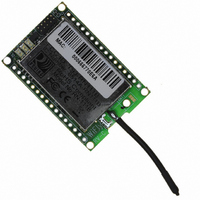RN-111B-W Roving Networks Inc, RN-111B-W Datasheet - Page 16

RN-111B-W
Manufacturer Part Number
RN-111B-W
Description
MODULE WIFLY 802.11B 1/4 WV-WIRE
Manufacturer
Roving Networks Inc
Specifications of RN-111B-W
Frequency
2402MHz ~ 2480MHz
Data Rate - Maximum
200kbps
Modulation Or Protocol
DSSS
Power - Output
12dBm
Sensitivity
-93dBm
Voltage - Supply
3.3V
Current - Receiving
40mA
Current - Transmitting
120mA
Data Interface
PCB, Surface Mount
Memory Size
500kBytes Flash
Antenna Connector
On-Board, Wire Antenna
Package / Case
Module
Wireless Frequency
2.40 GHz to 2.48 GHz
Interface Type
UART, SPI
Board Size
1 in x 1.5 in x 0.2 in
Modulation
CCK, DBPSK, DQPSK, DSSS
Security
AES, WEP128, WPA-PSK, WPA2-PSK, TKIP
Operating Voltage
3 VDC to 16 VDC
Antenna
1/4 Wave Wire
Lead Free Status / RoHS Status
Lead free / RoHS Compliant
Operating Temperature
-
Applications
-
Lead Free Status / Rohs Status
Lead free / RoHS Compliant
Other names
740-1026
pullup to 1.2VDC may need be used if the circuit has an impedance (due to leakage current)
of less than 5Mohms ( 500mv / 100nA ). SENS1-4 pins that are not used should be left
unconnected.
When the module is in Sleep mode, the UART itself is disabled. However, wake on UART
can be accomplished by connecting the SENS1 pin to the RX data pin.
To enable or disable this function, use: set sys trig 1.
It should be noted that the first byte sent into the module will likely be lost, so the designer
should take care to send a preamble byte to wake up the module before sending valid data
bytes.
The UART receive buffer is approx. 1024 bytes, and at lower baudrates (9600, 19200) the
system can process data into the device without need for flow control.
If constant streaming of data into RX on the device is required, care should be taken to set the
comm parameters to optimize the performance. If data has a termination char, this can be
used. Also, if data has a particular frame size, this can be used.
The comm size is automatically set whenever the baudrate is set, but should be modified if
needed.
Even at higher baudrates (115K and higher ) it is possible to operate without flow control if
packets are uniform and a protocol is used to ensure that data is delivered on the remote side
before the next packet is sent.
However, given the uncertainty of packet delays in a TCP/IP network and the affects of loss
and retries inherent in wireless networks, flow control is usually required to guarantee no data
is lost.
GPIO 2 and 3 implement UART hardware flow control if enabled.
By default flow control is disabled. To enable hardware flow contol, use
et sys mask <hex val>






















